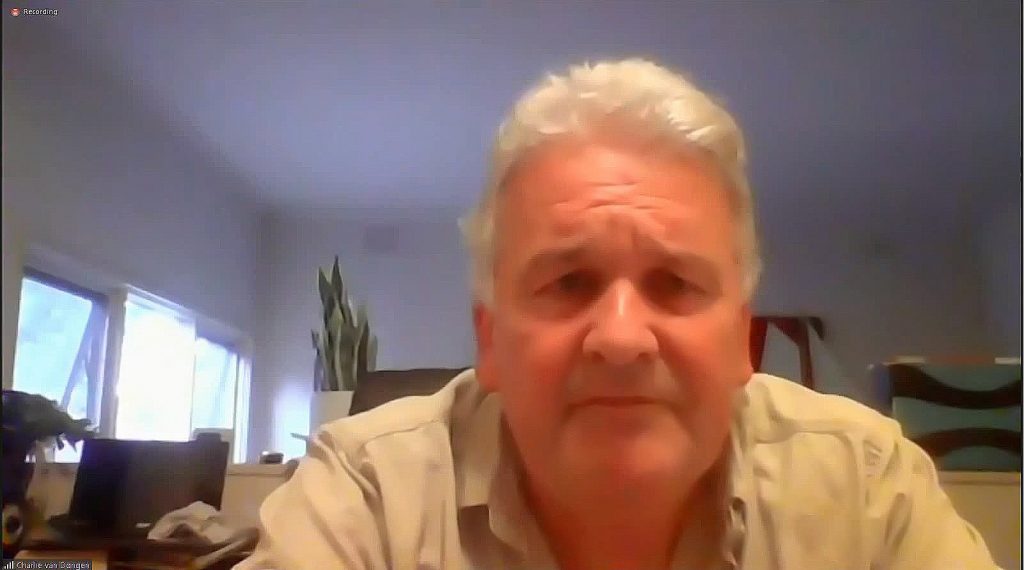Meeting Report
On Monday 15th February, the Melbourne Section of the AES held our regular bi-monthly meeting in the form of a Zoom Meeting. There was a strong attendance of more than 25 members and visitors.
Chair Graeme Huon introduced Charlie Van Dongen of Involve Audio to give us a presentation on his company’s work on modern surround audio encoding and decoding and speaker design.
Charlie started by recounting his early experiences with surround, starting with the Dynaco decoder, and the quad systems that followed in the ‘70s. He suggested that the reason for the formats’ failure in that era was the market confusion created by the number of competing systems. Moving to the present day, he commented that despite the current crop of surround systems, the predominant format is still stereo, given the number of portable and personal media playback devices. He cited a market survey by one 5.1 system vendor in the ‘90s that indicated that 60% of their systems were incorrectly set up to provide a stereo-only experience, with rear speakers either not connected or wrongly placed adjacent to the front speakers.

AES Melbourne Section – Screenshot by Rod Staples.
He mentioned the entry of Dolby into the arena in the late 1970s with ProLogic, and how the addition of the centre channel changed the landscape, but he did express his own disappointment with the vertical offset evident in this centre channel, which somewhat spoiled the experience.
He indicated that he did not revisit surround sound until 2008, when he pivoted his electronics manufacturing company ahead of an expected downturn in business from his communications electronics clients. Becoming aware of the work of Rob Mackinlay (ER Audio) with electrostatic loudspeakers triggered a collaboration in design and manufacturing in this field, with Rob’s mechanical engineering background complementing Charlie’s audio/electronic engineering expertise.
Charlie went on to describe some of their electrostatic loudspeaker designs, including one built for Nakamichi, which unfortunately never made it to market under that brand due to Nakamichi’s parent company running into financial difficulties. Then he described the later demand for miniaturization of the panels to make a product more suited to the current ascetic, and the challenges associated with that.
Charlie then addressed the issue of “good sounding” loudspeakers testing badly, and vice versa, and described some of their work in identifying key factors to feed into their designs.
He then went on to discuss the problem of the restricted sweet-spot of most systems, and described Involve’s patented Sweet Spot Technology (SST) which greatly broadens the sweet-spot range.
Charlie then moved on to describe the Involve surround matrix encode/decode system. He described how they started with the Sansui SQ system, varying the matrix equations, and creating a 3-band system using DSP with added psycho-acoustic effects better mimicking human hearing to improve accuracy. He noted that using DSP eliminated the tolerance errors which had plagued analog systems.
He discussed another shortcoming of some legacy encoders, being a collapse of separation (sometimes to less than 8dB). He described the tests they undertook using a diverse panel of listeners to ascertain the minimum acceptable separation, which turned out to be 12dB.
He then presented a table showing the separation performance of the Involve encode/decode process, which demonstrated that even on steady-state (tone) testing it never fell below 12dB of separation and for most combinations well exceeded that, averaging 30dB. Dynamic tests (using music) gave even better results with nothing less than 35dB and average separation of 37dB.

He went on to describe tests with their listening panel which indicated that the Involve encode/decode was more than the equal of a discrete surround playback.
Results even showed a preference for the Involve system over a discrete system.
A Q&A session followed Charlie’s presentation, where he fielded questions on the makeup of the listening panel, the choice of listening panel music source material and hardware configuration, as well as connector design considerations for his electrostatic loudspeakers.
We thank Charlie for a most interesting session, and look forward to an opportunity to hear his systems in operation at a demo night sometime in the future when COVID restrictions permit.
An edited version of the Zoom video is below:
The video is also available on YouTube at https://www.youtube.com/watch?v=Y_8BFrGWRKE
A PDF version of Charlie’s slide deck is available here
Links:
Involve Audio: http://involveaudio.com/
ER Audio (Rob Mackinlay) http://www.eraudio.com.au/
QuadraphonicQuad forums website https://www.quadraphonicquad.com/forums/
Involve Audio sub-forum https://www.quadraphonicquad.com/forums/forums/involve-audio-creators-of-the-surround-master.177/
